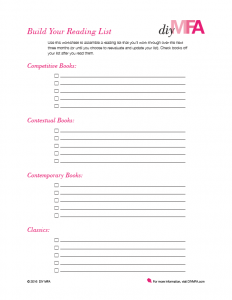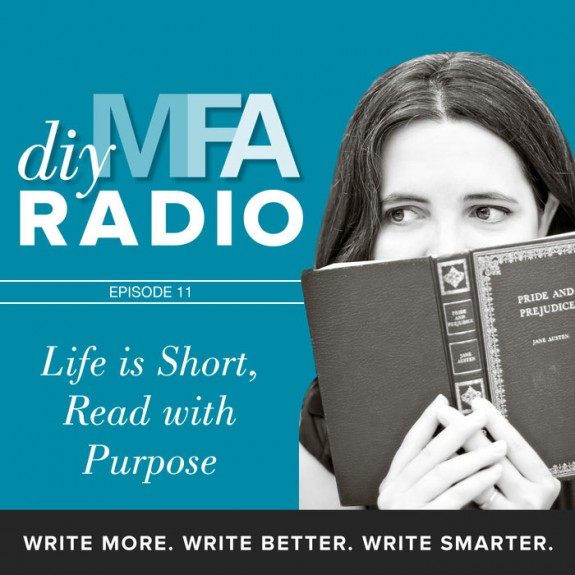Reading with purpose is one of the core principles in DIY MFA. Sure, reading for pleasure is great–it inspires you and fuels your passion for writing. But, in order to grow and learn as a writer, you have to read like a writer and use what you read to improve your craft and technique.
In today’s episode, I’ll go over three key steps to help you read with purpose. These steps are: building a reading list, reading with a writer’s eye, and responding to (and remembering) what you read.
Listen in for the details.
Choose your books and build a reading list.
When you read with purpose, you need to be strategic about the books you choose. Build a reading list that will help you grow as a writer, with books that are targeted to help you develop your work in progress. There are four main categories of books that should go on your “To Be Read” (TBR) list.
- Competitive: These are books that directly compete with what you are currently writing. Reading these books will help you answer several questions. Who is publishing books like yours? Who is agenting books like yours? Who is reading books like yours? Where would your book live “on the shelf”?
- Contextual: These books are part of your background research. They have similar themes as your work in progress (WIP), but are not direct competitors.
- Contemporary: These are books that are very new. They don’t need to be on the same topic as your work in progress, but they should have been published in the past 1-2 years. These books can be in any genre, though you’ll want to be especially well-versed in the contemporaries in the same category as your WIP. Why read contemporary books? Because you need to know what’s current and what books are getting a lot of buzz.
- Classics: This category covers any classic books in your genre or category. (Since literature changes so quickly, I consider anything written before the year 2000 a classic. Depending on your genre, the cut-off for a classic in your field might be earlier or later than 2000.) When reading classics, ask yourself: What has given these books their “staying power”? Why have they lasted as classics while other books fizzled out? What can you learn from these books?
 Keep your reading list goal reasonable. 15-20 books a year is a good target, but choose a number that works for you. Shoot for a number that motivates you to keep reading but doesn’t overwhelm you.
Keep your reading list goal reasonable. 15-20 books a year is a good target, but choose a number that works for you. Shoot for a number that motivates you to keep reading but doesn’t overwhelm you.
You can use ReadingList to stay organized.
Read like a writer
The best advice I can give you here is to share two books that have had a huge impact on my reading and growth as a writer. These books are:
Reading Like a Writer
by Francine Prose
Ordinary Genius: A Guide for the Poet Within
by Kim Addonizio
Respond to what you read
Take in what you read, think it through, and then take some time to respond in a way that works for you. As a writer, chances are you’re used to “thinking on paper” so a written response can be a great way to review and understand what you read. Maybe you write a review on Goodreads. Maybe you keep notes in a journal. How you respond is up to you. Use a method that will help you to process what you have read and remember the important details later on.
Remember, the best practice is the one that works for you.
Link to Episode 11
(Right-click to download.)
If you liked this episode…
Head over to iTunes, leave a review, and subscribe so you’ll be first to know when new episodes are available. Also, if you know anyone who might enjoy this podcast, please share!
Until next week, keep writing and keep being awesome.








